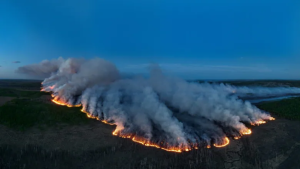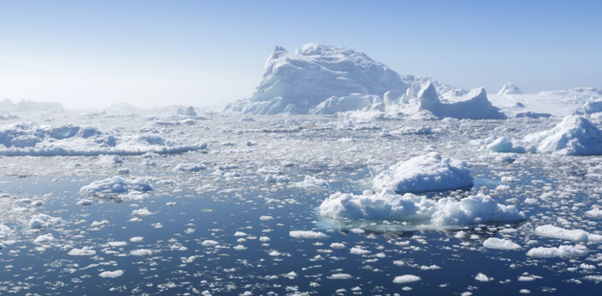By Kim McInroy, MoveUP Environment Committee member
The Arctic, known for its icy landscapes and majestic wildlife, is experiencing a profound transformation driven by the Earth’s escalating heat. One of the most alarming consequences is the disappearance of Arctic summer ice, a critical indicator of climate change.
Rising global temperatures, predominantly attributed to human-induced greenhouse gas emissions, are causing the Arctic to warm at an unprecedented rate. As temperatures increase, the Arctic’s summer ice cover undergoes a steady decline, leading to the disintegration of vast stretches of ice. This phenomenon not only impacts the Arctic region but also reverberates across the globe.
Over the past few decades, scientific observations and satellite data have documented the remarkable reduction in Arctic summer ice. Since the 1980s, the ice cover has shrunk by approximately 50%, with recent years witnessing record-breaking lows. Disturbingly, climate models indicate that if current trends persist, the Arctic could be devoid of summer ice within the next decade. Previously it was predicted to occur within the next 3 decades.
The disappearance of Arctic summer ice has the following major impacts:
- Amplifying Global Warming: Arctic ice acts as a reflective surface that bounces solar radiation back into space. As ice melts, the exposed dark ocean absorbs more heat, exacerbating global warming. This vicious cycle intensifies the warming effect on the Earth’s climate system.
- Disturbing Ecosystems: Arctic summer ice is a vital habitat for numerous species, including polar bears, seals, and walruses. The loss of ice disrupts their natural patterns, hindering hunting, breeding, and migration, thus jeopardising their survival. The effects ripple through the food chain, affecting the entire Arctic ecosystem.
- Rising Sea Levels: Melting Arctic ice contributes to the rise in global sea levels. As ice sheets and glaciers melt, they discharge water into the oceans, threatening coastal regions and low-lying areas with increased flooding and erosion risks.
- Altered Weather Patterns: The Arctic plays a crucial role in regulating global climate patterns. Its ice cover helps maintain stability in ocean currents and atmospheric circulation, influencing weather systems worldwide. As Arctic ice diminishes, the delicate balance of these patterns is disrupted, potentially leading to extreme weather events, including heatwaves, storms, and prolonged droughts.

We are already seeing these types of extreme weather events, which will only continue to grow in intensity in the decade to come. We need to start making real changes to our own individual carbon footprints to reduce the impact on the environment now, to slow this progression as best as we can. Or, what we have already seen this spring alone, with the extreme drought like conditions and massive amounts of scorched earth, will happen faster and earlier with more intensity each year going forward.
Ways that your family can contribute to healing the planet:
Individuals play a crucial role in addressing the challenges associated with the melting of Arctic summer ice. Here are some calls to action that individuals can undertake to contribute to slowing down the melting process:
- Reduce Carbon Footprint: Take steps to reduce your carbon emissions by adopting sustainable habits. Use energy-efficient appliances, opt for public transportation or carpooling, and choose renewable energy sources whenever possible. Small changes in daily routines can have a cumulative impact on reducing greenhouse gas emissions.
- Conserve Energy: Be mindful of your energy consumption. Turn off lights when not in use, unplug electronic devices, and adjust thermostats to reduce energy consumption. By reducing energy usage, you indirectly contribute to lowering the demand for fossil fuel-generated electricity.
- Consume Responsibly: Make conscious choices in your consumption habits. Opt for sustainable and locally sourced products, minimize waste, and choose environmentally friendly options. By supporting businesses and industries that prioritize sustainability, you contribute to reducing overall carbon emissions.
- Inspire Others: Lead by example and inspire those around you to take action. Encourage friends, family, and colleagues to join you in adopting sustainable practices and making conscious choices that contribute to slowing down the melting of Arctic summer ice and impact on global warming.
Other articles to read:
National Geographic: Arctic summer sea ice could disappear as early as 2035 (August 13, 2020)
Your Environment Committee is looking for more members. If you share the same passion for the survival of our planet, please consider joining our committee by reaching out to our committee co-chair Kelly Cammack, your VP, or any other member on the committee. We need your help, the earth needs your help.



